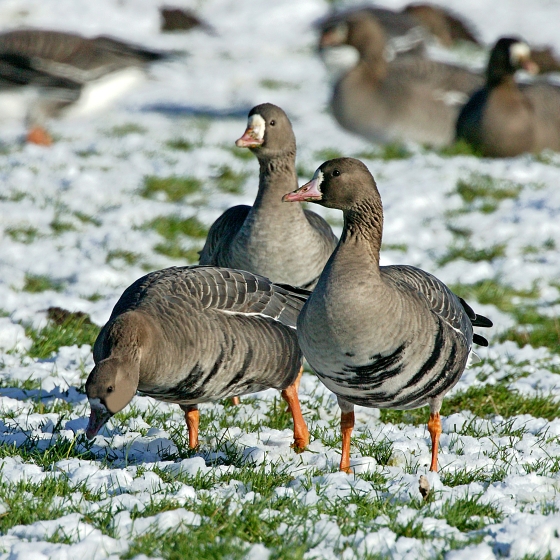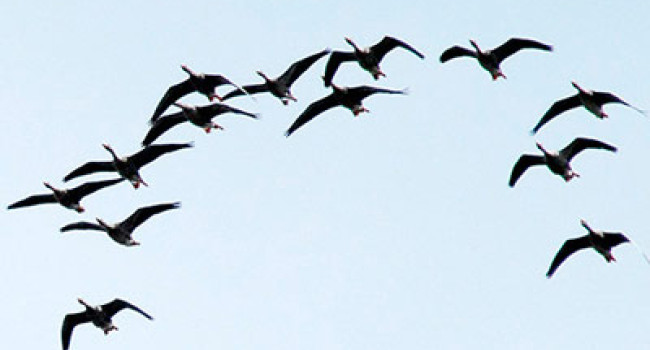White-fronted Goose
Anser albifrons (Scopoli, 1769)
WG
 WHFGO
WHFGO  1590
1590

Family: Anseriformes > Anatidae

This small, grey goose with white forehead blaze and black belly-bars is a winter visitor to wetlands and coastal marshes.
Two races of White-fronted Goose occur in the UK: the nominate race albifrons, which breeds in western Russia and is referred to as Russian, or European White-fronted Goose, and flavirostris, which breeds in western Greenland and is called Greenland White-fronted Goose. Greenland White-fronted Geese occur in the north and west of Britain and Ireland, whilst Russian White-fronted Geese can be found in the south and east.
Wetland Bird Survey data show the range of sites where the two races winter, and it is estimated that 10,000–12,000 Greenland White-fronts and 1,000–2,000 Russian White-fronts spend the winter months here in the UK.
Identification
White-fronted Goose identification is often straightforward. The following article may help when identifying White-fronted Goose.
SONGS AND CALLS
Listen to example recordings of the main vocalisations of White-fronted Goose, provided by xeno-canto contributors.
Call
Develop your bird ID skills with our training courses
Our interactive online courses are a great way to develop your bird identification skills, whether you're new to the hobby or a competent birder looking to hone your abilities.
Browse training coursesStatus and Trends
Population size and trends and patterns of distribution based on BTO surveys and atlases with data collected by BTO volunteers.
CONSERVATION STATUS
This species can be found on the following statutory and conservation listings and schedules.
DISTRIBUTION
Two distinctive subspecies of White-fronted Goose winter in Britain and Ireland. There is little range overlap, with the ‘European’ (albifrons) subspecies occurring mainly in southern England, and the ‘Greenland’ (flavirostris) subspecies occurring predominantly in Ireland and western and northern Scotland.
Occupied 10-km squares in UK
| No. occupied in winter | 579 |
| % occupied in winter | 19 |
European Distribution Map
DISTRIBUTION CHANGE
The two subspecies of White-fronted Goose were not reported separately during the 1981–84 Winter Atlas, thereby limiting range-change calculations to the species level. Nevertheless, knowledge of the general distribution of the two forms helps when interpreting the change map, which shows a 10% range contraction in Ireland compared with a 36% expansion in Britain, most notably in south-east England, along the east coast of England and in south and east Scotland.
| % change in range in winter (1981–84 to 2007–11) | +33.2% |
SEASONALITY
White-fronted Geese are winter visitors, present from October to April, with occasional stragglers and naturalised birds at other times.

Movement
Information about movement and migration based on online bird portals (e.g. BirdTrack), Ringing schemes and tracking studies.
An overview of year-round movements for the whole of Europe can be seen on the EuroBirdPortal viewer.
RINGING RECOVERIES
View a summary of recoveries in the Online Ringing Report.
Foreign locations of birds ringed or recovered in Britain & Ireland

Biology
Lifecycle and body size information about White-fronted Goose, including statistics on nesting, eggs and lifespan based on BTO ringing and nest recording data.
SURVIVAL & LONGEVITY
View number ringed each year in the Online Ringing Report
Maximum Age from Ringing 
|
18 years 9 months 22 days (set in 2004) 
|
Typical Lifespan 
|
6 years with breeding typically at 3 year |
Adult Survival 
|
0.724±0.072  
|
Juvenile Survival 
|
0.596 (in first year) 
|
CODES & CLASSIFICATION
Ring size 
|
K |
Field Codes 
|
2-letter: WG | 5-letter code: WHFGO | Euring: 1590 |
For information in another language (where available) click on a linked name
Links to more studies from ConservationEvidence.com
- Use of Willapa Bay, Washington, by shorebirds and waterfowl after Spartina control efforts
- Reintroduction of the critically endangered Campbell Island teal Anas nesiotis to Campbell Island, New Zealand
- Effects of grazing and inundation on pasture quality and seed production in a salt marsh
Read more studies about White-fronted Goose on Conservation Evidence >
Would you like to search for another species?










Share this page